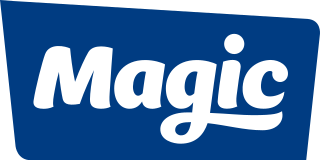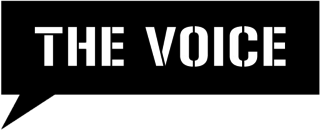
MTV2 is an American pay television channel owned by the Paramount Media Networks division of Paramount Global, through PMN’s MTV Entertainment Group Subdivision.

Much is a Canadian English language discretionary specialty channel owned by BCE Inc. through its Bell Media subsidiary that airs programming aimed at teenagers and young adults. Prior to 2013, the channel was officially known as MuchMusic, though "Much" has been the branding most commonly seen on-air since 1997.

M3 was a Canadian English language Category A cable and satellite specialty channel owned by Bell Media. Established in 1998 as MuchMoreMusic, the network began as a spin-off of the youth-oriented MuchMusic, targeting an older demographic with adult contemporary and classic music videos, along with music news programs, concert specials, and pop culture programming.

Nick at Nite is a nighttime programming block on the American basic cable channel Nickelodeon. Broadcasting from prime time to late night, the block intitally consisted of syndicated sitcoms and films from the 1950s to the 1970s. Nick at Nite gradually shifted its programming to primarily airing sitcoms as recent as the mid-1990s to the 2010s.

Television in Australia began experimentally as early as 1929 in Melbourne with radio stations 3DB and 3UZ, and 2UE in Sydney, using the Radiovision system by Gilbert Miles and Donald McDonald, and later from other locations, such as Brisbane in 1934.

SBS Broadcasting Group (SBS), formerly Scandinavian Broadcasting Systems, was a European multinational media group, operating commercial television, premium pay channels, radio stations and related print businesses in Northern, Western and Central and Eastern Europe. It became the second-largest broadcaster in Europe.
CityNews is the title of news and current affairs programming on Rogers Sports & Media's Citytv network in Canada. The newscast division was founded on September 28, 1975 as CityPulse as a standalone local newscast on the network's Toronto station owned by CHUM Limited. Through the acquisitions of the Edmonton, Winnipeg and Calgary A-Channel stations in 2004, it was relaunched under the CityNews brand on August 2, 2005 and later expanded to Montreal in 2012. The remaining Citytv stations airs the news headlines segments during each station's Breakfast Television morning show.

Fuse is an American pay television channel owned by Fuse Media, LLC, that launched in 1994.
Kerrang! TV is a British music television channel owned by Channel Four Television Corporation, with permission to use the Kerrang! brand from Bauer. The channel primarily broadcasts music videos on an open schedule, so as to permit text requests for their playlists.

C4 was a New Zealand television channel owned and operated by MediaWorks New Zealand. C4 was available on both digital terrestrial and satellite platforms and played music around the clock, including music from C4's sister radio division from The Rock, The Edge, The Breeze, More FM, George FM, Mai FM & The Sound. C4 also aired a lot of speciality music shows such as HomeGrown, Top 10/100, Video Hits, Fade To Black, Steel Mill, the UChoose40 and the Biggest Records Right Now. The channel was originally launched on Friday 3 October 2003 at 08:00pm as a re-branding of TV4 which had been broadcasting since 1997. On 1 May 2010, as C4 had been moving away from music programming since 2008, the jukebox side was split off and C4 launched a second C4 channel on Channel 9 called C4 2. C4 2 was only available on digital Freeview terrestrial and satellite platforms. At the end of 2010 an announcement was made that MediaWorks would again re-brand the current C4 channel as FOUR, which meant C4 2 would be converted to a music show as C4 was moved to its Channel 9 position. C4 shut down on Thursday 26 June 2014 at 01:00 am. It was replaced by The Edge TV the next day on Friday 27 June 2014 at 04:00 pm. Nearly a decade later on 17 October 2023 two weeks after the official 20th anniversary, The Spinoff paid tribute to C4 in a podcast video on YouTube celebrating C4's 20 year anniversary.

MTV Rocks was a British pay television music channel that was operated by ViacomCBS Networks UK & Australia. Its programming consisted of 24-hour non-stop rock/alternative music.

Magic is a British music television channel owned by Channel Four Television Corporation. It plays mainly easy listening music videos and is based on the Magic radio station owned by Bauer Media Audio UK. Magic mainly focuses on music from the 1970s to the present day. During throughout the Christmas of each year, The channel will only plays Christmas music under their block called "Christmas is Magic".

WDNI-CD is a low-power, Class A television station in Indianapolis, Indiana, United States, affiliated with the Spanish-language Telemundo network. The station is owned by the Radio One subsidiary of Urban One as its only broadcast television property. WDNI-CD's studios are located at Urban One's Indiana headquarters on East St. Joseph Street in downtown Indianapolis, and its transmitter is located on North Hawthorne Lane and 23rd Street on the city's near-northeast side.

The Voice TV was the name of a Danish television station that broadcast music videos 24 hours a day. 7'eren was launched on January 1, 2012, as a programming block on The Voice TV, and a year later, on January 1, 2013, the channel renamed The Voice TV into 7'eren, by rebranding itself as a channel for youth programming.

National Indigenous Television (NITV) is an Australian free-to-air television channel that broadcasts programming produced and presented largely by Aboriginal and Torres Strait Islander people. It includes the six-day-a-week NITV News Update, with programming including other news and current affairs programmes, sports coverage, entertainment for children and adults, films and documentaries covering a range of topics. Its primary audience is Indigenous Australians, but many non-Indigenous people tune in to learn more about the history of and issues affecting the country's First Nations peoples.

Cable news channels are television networks devoted to television news broadcasts, with the name deriving from the proliferation of such networks during the 1980s with the advent of cable television.

The Voice is a European radio station operating in Denmark and Bulgaria. It was available until 2012 in Finland and in Sweden until broadcasts stopped online early 2020. The Nordic radio stations are were owned by Bauer Media Group, and the Bulgarian station was owned by A.E. Best Success Services Bulgaria EOOD until 2022 since then it is owned by Nova Radio Group. The format consists mostly of new Pop songs, real life events and concerts like the local Coca Cola The Voice Happy Energy Tour. The target audience of the listeners is 15 to 25 years old. Income is generated by commercials. The station was founded in Denmark as a local radio in the Copenhagen area.
SBS PopAsia is an Australian digital radio station that broadcasts music, most notably from East Asia and Southeast Asia, on digital radio, online and on mobile devices. The station originated as a two-hour segment on SBS youth radio programme Alchemy before launching as a stand alone digital radio station in 2010.

The Edge TV was a New Zealand online streaming channel that was officially launched as a television channel on 27 June 2014 as an extension of The Edge radio brand, which is owned by MediaWorks New Zealand. In September 2020, MediaWorks sold The Edge TV along with its entire television arm to the United States multinational mass media company Discovery, Inc., with the acquisition being finalised in December 2020. MediaWorks still produces the content which is broadcast on frequencies owned by Discovery Inc. On 21 March 2022, The Edge TV returned to being an online-only streaming channel, alongside sister channel Breeze TV. Both The Edge TV and Breeze TV were closed in December 2022.

WatsUp TV is a 24 hour digital entertainment Television channel made for the Pan-African Bi-Lingual community and also aired on various television channels across Africa founded by Abd Traore.




















